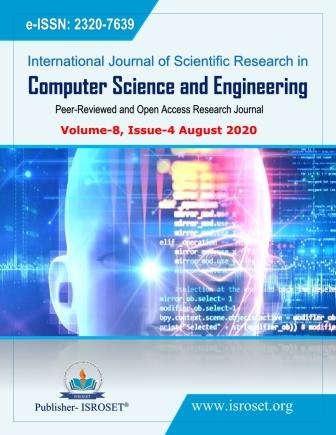Speech Recognition for COVID-19 Keywords Using Machine Learning
Keywords:
COVID-19, Support Vector Machine, Artificial Neural NetworkAbstract
As of June 01, 2020, coronavirus disease, 2019 (COVID-19) has been confirmed in 7,274,000 people worldwide, affecting over 213 countries. It becomes a major healthcare challenge around the world to counter this novel epidemic. The aim of this study is to investigate the detection of patients with suspected COVID-19 infection through phone calls. Artificial Neural Network (ANN) and Support Vector Machine (SVM) classifiers for detection to COVID patients are built and their performances are compared. Experiments were carried out on Arabic speech signals of recorded phone calls. From speech signals, relevant feature extraction of keywords is achieved. The results are very promising. We have reached 97% accuracy. Thanks to this classification, we would be able to know if the recorded call deserves a callback or not which would ease the workload on the health care system. The model can evolve by building better and more solid classifiers that can be used in public security when it comes to analyzing phone calls
References
A. S. S. Rao, and J. A. Vazquez, ?Identification of COVID-19 can be quicker through artificial intelligence framework using a mobile phone-based survey in the populations when cities/towns are under quarantine," Infection Control & Hospital Epidemiology, vol.41 no 7, pp. 826-830, 2020.
O. Abdel-Hamid, A. Mohamed, H. Jiang, L. Deng, G. Penn, and Y. Dong, ?Convolutional neural networks for speech recognition,? Journal of IEEE/ACM Transactions on audio, speech, and language processing, Vol.22, pp.1533-1545, 2014.
J. Samuel, G.G. Ali, M Rahman, E. Esawi, Y, ?Covid-19 public sentiment insights and machine learning for tweets classification,? Information, vol. 11, no 6, pp. 314, 2020.
R. Vaishya, M. Javaid, I. H. Khan et A. Haleem, ?Artificial Intelligence (AI) applications for COVID-19 pandemic,? Diabetes & Metabolic Syndrome: Clinical Research & Reviews, 2020.
S. K. Gaikwad, B. W. Gawali, and P. Yannawar, ?A review on speech recognition technique,? International Journal of Computer Applications, vol. 10, no 3, pp. 16-24, 2010.
H. Bouhamed, ?Covid-19 cases and recovery previsions with deep learning nested sequence prediction models with long short-term memory (LSTM) architecture,? Int. J. Sci. Res. in Computer Science and Engineering, vol. 8, no 2, 2020.
L. Yan, H. Zhang, Y. Xiao, et al. ?Prediction of survival for severe Covid-19 patients with three clinical features: development of a machine learning-based prognostic model with clinical data in Wuhan,? medRxiv, 2020.
Z. I. Khan, Y. Javed, and K.N. Shmasi ?Correlation study of New Cases, Deaths, Recoveries and Temperature with Machine Learning during COVID-19 spread in Saudi Arabia,? Int. J. Sci. Res. in Computer Science and Engineering, vol. 8, no 3, 2020.
B.W. Schuller, D.M. Schuller, K. Qian, J. Liu, H. Zheng, and X. Li ?Covid-19 and computer audition: An overview on what speech & sound analysis could contribute in the SARS-CoV-2 Corona crisis,? arXiv preprint arXiv:2003. 11117, 2020.
E. Guresen, and G. Kayakutlu, ?Definition of artificial neural networks with comparison to other networks,? Procedia Computer Science, vol. 3, pp. 426-433, 2011.
M.M. Mijwel, ?Artificial neural networks advantages and disadvantages,? Retrieved from LinkedIn: https://www. linkedin. com/pulse/artificial-neural-net works-advantages-disadvantages-maad-m-mijwel, 2018.
C. Campbell, and Y. Ying. ?Learning with support vector machines,? Synthesis lectures on artificial intelligence and machine learning, vol. 5, no. 1, pp. 1-95, 2011.
P. Virtanen, R. Gommers, T.E. Oliphant, Haberland, M. Haberland, T. Reddy, D. Cournapeau, ... & van der Walt, S. J. SciPy 1.0: ?fundamental algorithms for scientific computing in Python. Nature methods,? vol. 17, no 3, pp. 261-272, 2020.
D. P. Kingma, and Ba. Jimmy ?Adam: A method for stochastic optimization,? arXiv preprint arXiv:1412.6980, 2014.
N. Cristianini, and J. Shawe-Taylor. ?An introduction to support vector machines and other kernel-based learning methods,? Cambridge university press, 2000.
Pedregosa, F., Varoquaux, G., Gramfort, A., Michel, V., Thirion, B., Grisel, O., ... & Vanderplas, J. ?Scikit-learn: Machine learning in Python,? the Journal of machine Learning research, vol. 12, p. 2825-2830, 2011.
Downloads
Published
How to Cite
Issue
Section
License

This work is licensed under a Creative Commons Attribution 4.0 International License.
Authors contributing to this journal agree to publish their articles under the Creative Commons Attribution 4.0 International License, allowing third parties to share their work (copy, distribute, transmit) and to adapt it, under the condition that the authors are given credit and that in the event of reuse or distribution, the terms of this license are made clear.







